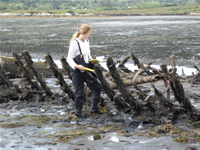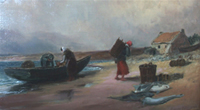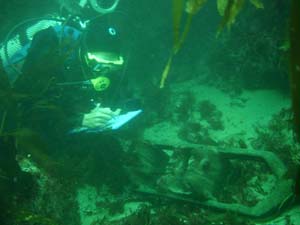
Achill is Ireland’s largest island, located off the traditionally remote coast of Co Mayo between Clew and Blacksod Bays. Long renowned for its magnificent vistas, dynamic coastline, and friendly communities, Achill today sees a regular influx of visitors during the summer months while still retaining an atmosphere of isolation. An ongoing excavation program implemented by the Achill Folklife Centre has brought much attention to the many archaeological sites situated across Achill’s rugged landscape. Until recently the island’s rich maritime heritage has been mostly under-appreciated.
Thousands of years of human activity on Achill have left their traces along the seafloor, foreshore, and coastline. Prehistoric settlement sites flooded by rising waters and nearby coastal sites reflect ties to the sea of an ancient island people. The ships of Viking raiders, medieval traders, pirates, privateers, and foreign invaders have all plied the waters around Achill, and their shattered hulls and cargos remain undiscovered offshore. In addition to the three Spanish Armada wrecks known to have been lost in the area, other known shipwrecks in Achill’s waters date to later periods, including that of the Great Famine (mid-nineteenth century).

In addition to providing avenues of conflict, commerce, colonial expansion, and Diaspora, the sea has provided life and livelihoods for countless generations of islanders. Rocky shores, sandy beaches, tidal flats, and natural harbors have fostered subsistence and then commercial fishing by boats, nets, and weirs, seaweed cultivation, salt production, and shipwreck salvage. Irish boatbuilding dates as far back as 7,000 years, when dugout canoes were used by prehistoric mariners, and has evolved into two distinct Irish watercraft traditions: the planked boat, and the skin boat. The latter, known as curraghs, were noted as early as the 3rd century AD by Roman chroniclers, and are still used on the island. The maritime environment, as a provider of subsistence and as a connection to England, Europe, and the greater Atlantic world, has always played a major role in the shaping of the Irish sociocultural landscape.
The Achill Maritime Archaeology Project was launched in the summer of 2004, and is sponsored by the College of William and Mary in Williamsburg, Virginia, the Achill Folklife Centre in Dooagh, Achill, and the Institute of Maritime History. Directed by Chuck Meide, this field research will serve as the subject of his Ph.D. dissertation in the Program of Historical Archaeology and Anthropology at the College of William and Mary.
Economic Relations on the 19th century maritime cultural landscape

The analysis of the project data explores how the sea and surrounding maritime landscape have shaped social and economic relations on Achill throughout the nineteenth and early twentieth centuries. To islanders off the remote western coast of Ireland, a shipwreck meant more than just a catastrophic event entailing a tragic loss of life; it also represented a source of otherwise unattainable material goods, a means of sustenance, and a connection to a wider world market. Passing vessels participating in this global economic system were also sources of income for local watermen serving as pilots, and might provide another avenue of consumer goods through informal bartering. I am particularly interested in the capitalization of traditional kin-ordered and subsistence-based fishing practices which took place throughout the nineteenth century, but especially after the introduction of a commercial salmon fishing industry by a Scottish entrepreneur named Alexander Hector in the 1850s. This process was deliberately fostered by both coercive and conciliatory efforts of the British government, and led to the change of design of traditional Irish watercraft, the abandonment of such small boats in favor of introduced vessels of Scottish or Manx design, and the establishment of fish processing and curing stations on the island with the introduction of a wage labor system where none existed before.
The relationship between the local islanders and the British imperial government was often strained, and this tension regularly played out in the maritime landscape. By implementing Britain’s maritime policies, the coastguardsmen often came into direct conflict with local interests. The salvage of wrecked ships, long considered by the islanders an important source of commodities and the only source of timber for house construction, was clearly illegal by British law, and one of the primary purposes of the Coastguard was to protect the King’s right to material salvaged from wrecks. This could lead to violence; in one incident the murder of a Coastguardsman by an unknown islander was thought to have resulted from a dispute over salvage rights. In another instance, the Coastguard confiscated thirteen fishing curraghs, along with the nets, equipment, and catch of fish, on the grounds that the boats were not numbered or registered with the British government. As this occurred in 1847, at the height of the Famine, it may have doomed twenty-six families to starvation. The Coastguard, made up of Royal Navy men usually of the Anglican faith, often lent assistance to the evangelical Protestant mission established on the island at Dugort, which may have been another source of conflict within the mostly Catholic population.

Project archaeologists visiting Achill during the 2005 season explored these issues by searching for and investigating the physical remnants of economic activity on Achill’s maritime landscape. The site of the “Scotch House,” a 19th century fishing and processing factory associated with Alexander Hector’s salmon fishing operations, was located, cleared of vegetation, and mapped. In addition, a Famine-era Coastguard Station at Keem Bay was recorded for a planned 3-dimensional digital reconstruction. Archaeologists also conducted a preliminary investigation of the wreck of a late 19th/early 20th century fishing trawler named Successful, and dived on the remains of the English bark Neptune lost in 1860, and Irish ketch Charles Stewart Parnell, which was charged with supplying the local lighthouse when it wrecked in 1928. The team also recorded a number of anchors which had been raised from various shipwrecks, and several traditional vernacular watercraft, including a 100-year old Achill yawl.
